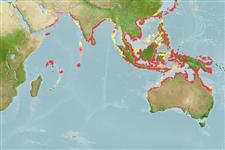Common names from other countries
Environment: milieu / climate zone / depth range / distribution range
Ecología
marino; agua dulce; salobre; anfidromo (Ref. 51243); rango de profundidad 10 - 13 m. Tropical; 31°N - 25°S, 52°E - 152°E
Indo-Pacific: Persian Gulf eastward to Myanmar, Andamans and Penang; Taiwan south to Arafura Sea (Ref. 9819), the northern coasts of Australia and Papua New Guinea; Sarawak; a record from the Bonin Islands; presumably the Philippines; perhaps not eastward to the Hebrides, etc.
Length at first maturity / Tamaño / Peso / Age
Maturity: Lm 16.6 range ? - ? cm
Max length : 27.0 cm SL macho / no sexado; (Ref. 30691); edad máxima reportada: 4 años (Ref. 127396)
Espinas dorsales (total) : 0; Espinas anales: 0; Radios blandos anales: 32 - 39. Belly with 23 to 26 keeled scutes from isthmus to anus. Tip of snout above level of eye center, usually about level of upper rim of eye. Maxilla short or moderate; first supra-maxilla small, oval. A dark blotch behind upper part of gill opening.
Coastal pelagic (Ref. 68964). Presumably schooling, inshore and entering estuaries. More precise data needed, based on correct identifications. If this is the species being referred to in Ref. 6841, then the principal food of the young would be prawns and copepods, supplemented by polychaetes and amphipods.
Whitehead, P.J.P., G.J. Nelson and T. Wongratana, 1988. FAO Species Catalogue. Vol. 7. Clupeoid fishes of the world (Suborder Clupeoidei). An annotated and illustrated catalogue of the herrings, sardines, pilchards, sprats, shads, anchovies and wolf-herrings. FAO Fish. Synop. 125(7/2):305-579. Rome: FAO. (Ref. 189)
IUCN Red List Status (Ref. 130435)
CITES (Ref. 128078)
Not Evaluated
Threat to humans
Harmless
Human uses
Pesquerías: comercial
Herramientas
Special reports
Download XML
Fuentes de Internet
Estimates based on models
Preferred temperature (Ref.
115969): 25 - 29.3, mean 28.6 (based on 1528 cells).
Phylogenetic diversity index (Ref.
82804): PD
50 = 0.5000 [Uniqueness, from 0.5 = low to 2.0 = high].
Bayesian length-weight: a=0.00617 (0.00467 - 0.00813), b=3.04 (2.97 - 3.11), in cm Total Length, based on LWR estimates for this species (Ref.
93245).
Nivel trófico (Ref.
69278): 3.5 ±0.51 se; based on food items.
Resiliencia (Ref.
120179): Alto, población duplicada en un tiempo mínimo inferior a 15 meses (K=0.66-1.32; tmax=4).
Fishing Vulnerability (Ref.
59153): Low vulnerability (16 of 100).
